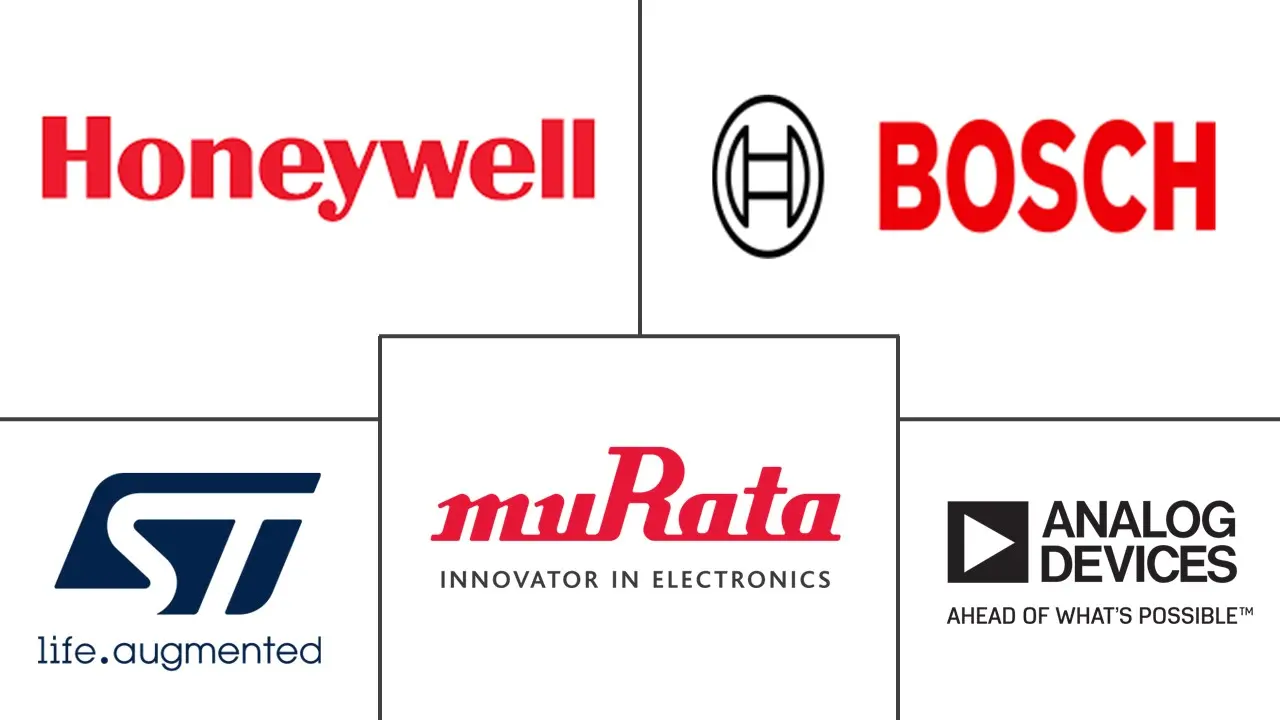Gyroscopes Market Size and Share
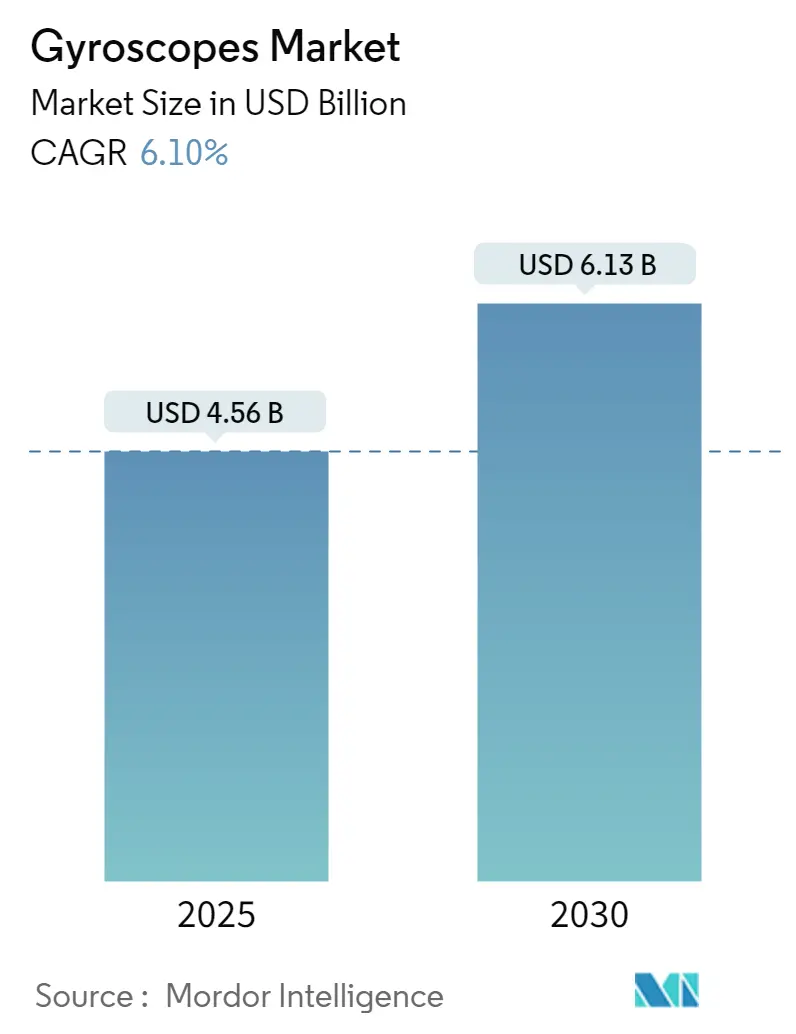
Gyroscopes Market Analysis by Mordor Intelligence
The Gyroscopes Market size is estimated at USD 4.56 billion in 2025, and is expected to reach USD 6.13 billion by 2030, at a CAGR of 6.1% during the forecast period (2025-2030).
The gyroscope industry is experiencing significant transformation driven by technological advancements and increasing integration across multiple sectors. The automotive sector has emerged as a crucial growth catalyst, with worldwide motor vehicle production exceeding 85 million units in 2022, of which passenger cars contributed approximately 73%. The integration of gyroscopes in advanced driver assistance systems (ADAS) has become increasingly vital for vehicle safety and performance optimization. These systems are becoming standard features in modern vehicles, with projections indicating that by 2026, approximately 71% of registered vehicles will be equipped with rear cameras and 60% with rear parking sensors.
The consumer electronics sector continues to drive innovation in gyroscope technology, particularly in the realm of 5G device integration and smart device functionality. China has maintained its position as the global leader in 5G technology adoption, accounting for over 60% of global 5G connections by the end of 2022. This dominance in the 5G market has created a robust ecosystem for gyroscope applications in smartphones, tablets, and other connected devices, fostering continued technological advancement and market expansion.
The industrial automation sector has witnessed substantial growth in gyroscope applications, particularly in robotics and precision manufacturing. According to the International Federation of Robotics, China has maintained its position as the world's largest industrial robot market since 2013, accounting for 52% of total installations in 2022. This trend reflects the growing importance of industrial gyroscope technology in ensuring precise motion control and stability in automated manufacturing processes.
The telecommunications infrastructure development across emerging economies is creating new opportunities for gyroscope applications. India's rapid 5G expansion exemplifies this trend, with projections indicating a dramatic increase in 5G mobile subscriptions from 6.66 million in 2022 to 699.84 million by 2028. This massive scale-up in telecommunications infrastructure is driving demand for gyroscope-equipped devices and systems, particularly in mobile devices and network equipment requiring precise orientation and stability control.
Global Gyroscopes Market Trends and Insights
Rapid Rise of Unmanned Vehicles in Both Defense and Civilian Applications
The proliferation of unmanned vehicles across both defense and civilian sectors has emerged as a primary driver for the gyroscope market. In the defense sector, the investment in UAV technology is experiencing significant growth, with research, development, and procurement costs projected to increase from USD 11.1 billion in 2020 to USD 14.3 billion by 2029. This expansion is further evidenced by substantial military initiatives, such as the Pentagon's 2023 announcement of a new program focused on building thousands of autonomous systems, including UAVs, to counter China's military capabilities.
The civilian sector has also witnessed remarkable growth in UAV applications, particularly in commercial and industrial uses. For instance, in May 2023, India-based Magnum Wings LLP unveiled the MW Viper, the country's first commercially available UAV, capable of hovering, taking off, and landing vertically with payloads between 5 and 60 kg. Similarly, in January 2023, the United Kingdom conducted its first-ever trial and evaluation of three heavy unmanned ground vehicles (H-UGVs), demonstrating the expanding scope of unmanned vehicle applications beyond aerial systems. These developments highlight the critical role of gyroscopes in ensuring precise navigation and stability across diverse unmanned vehicle applications.
Technological Advancements Enabling More Effective Components at a Smaller and Lighter Size
The miniaturization of gyroscope technology has revolutionized its applications across various industries. In January 2024, Murata unveiled the CH16T-K01, an inertial 6DoF XYZ-axis gyroscope and XYZ-axis accelerometer that enables high-precision machine control and positioning applications. This innovation demonstrates the industry's capability to produce smaller, more efficient devices while maintaining high performance standards, with features such as typical bias instability of 0.5 dph and 0.3 mdps/√Hz noise density.
The trend toward miniaturization has been particularly impactful in the mobile device sector, where space efficiency is crucial. Vendors worldwide are focusing on reducing MEMS size to enhance cost benefits while maintaining or improving performance. For example, in February 2022, STMicroelectronics launched its third generation of MEMS sensors for consumer mobiles, addressing the demand for smartphone chip-sized gyroscopic sensors. Additionally, in September 2022, Collins Aerospace was awarded a multi-million-pound program as part of the United Kingdom's Weapons Sector Research Framework to develop a navigation-grade Inertial Measurement Unit (IMU) using MEMS technology, demonstrating the growing adoption of miniaturized gyroscopes in critical applications.
Segment Analysis: By Technology
MEMS Gyroscope Segment in Global Gyroscopes Market
The MEMS Gyroscope segment dominates the global gyroscopes market, commanding approximately 46% market share in 2024, while also maintaining the highest growth trajectory for the forecast period 2024-2029 at around 9% CAGR. This segment's leadership position is driven by the increasing adoption in consumer electronics, particularly smartphones, tablets, and gaming devices, where MEMS gyroscopes enable screen rotation and motion sensing capabilities. The automotive sector's growing demand for these sensors in advanced driver assistance systems (ADAS) and autonomous vehicles further strengthens its market position. The segment's success is also attributed to its advantages including small size, low power consumption, high accuracy, and cost-effectiveness in mass production. Recent developments include the launch of new products like Murata's CH16T-K01, an inertial 6DoF XYZ-axis gyroscope in January 2024, demonstrating the continued innovation in this space.
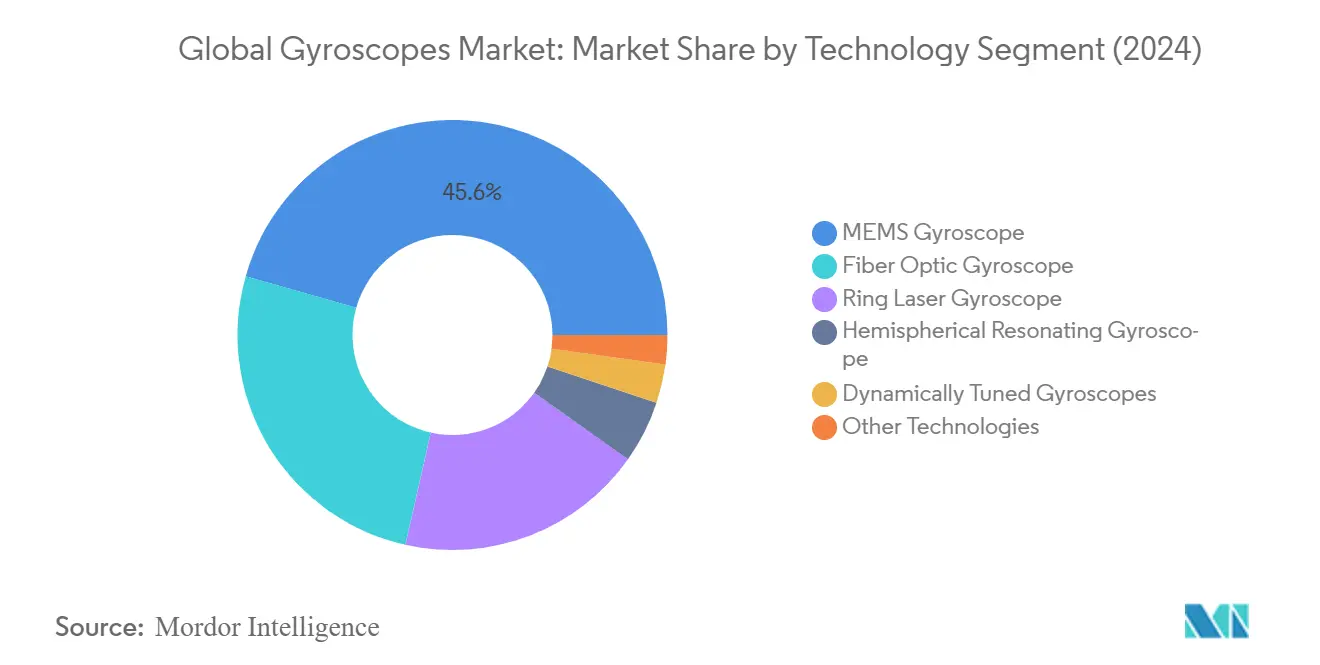
Remaining Segments in Gyroscopes Market by Technology
The remaining segments in the gyroscopes market include Fiber Optic Gyroscope (FOG), Ring Laser Gyroscope (RLG), Hemispherical Resonating Gyroscope (HRG), Dynamically Tuned Gyroscopes (DTG), and other technologies. FOG technology holds significant importance in aerospace and defense applications due to its high precision and reliability. RLG technology is crucial in aviation and military applications where accuracy is paramount. HRG technology finds its niche in satellite attitude control and space applications, while DTG serves specific industrial and military applications requiring dynamic tuning capabilities. Each of these technologies serves distinct market needs and applications, contributing to the overall market diversity and technological advancement in the gyroscope industry.
Segment Analysis: By End-User Vertical
Consumer Electronics Segment in Gyroscopes Market
The Consumer Electronics segment dominates the global gyroscopes market, accounting for approximately 38% market share in 2024. This significant market position is driven by the widespread integration of gyroscopes in smartphones, gaming consoles, computers, AR/VR devices, and GPS devices. The increasing adoption of gyroscopes in portable electronic devices for screen rotation, gaming controls, and image stabilization has been a key factor in maintaining this segment's leadership. The segment's growth is further supported by the rising demand for 5G devices, smart wearables, and the continuous innovation in consumer electronics applications requiring motion sensor and orientation detection capabilities. Major smartphone manufacturers are incorporating advanced gyroscopic sensors for enhanced user experience and functionality, particularly in camera stabilization and gaming applications.
Automotive Segment in Gyroscopes Market
The Automotive segment is emerging as the fastest-growing segment in the gyroscopes market, projected to grow at approximately 9% CAGR from 2024 to 2029. This remarkable growth is primarily driven by the increasing integration of advanced driver assistance systems (ADAS) and the rising demand for autonomous vehicles. The segment's expansion is further fueled by the growing adoption of electric vehicles and the implementation of stringent safety regulations requiring advanced sensing technologies. Gyroscopes play a crucial role in vehicle stability control, roll-over prevention, and navigation systems, making them indispensable components in modern automotive applications. The increasing focus on vehicle safety features and the development of self-driving capabilities are creating substantial opportunities for gyroscope manufacturers in the automotive sector.
Remaining Segments in End-User Vertical
The remaining segments in the gyroscopes market include Aerospace and Defense, Industrial, Marine, and Other End-user Verticals, each serving distinct applications and requirements. The Aerospace and Defense segment maintains a strong presence due to the critical role of gyroscopes in navigation systems, missile guidance, and aircraft stabilization. The Industrial segment is driven by the growing adoption of automation and robotics in manufacturing processes, while the Marine segment utilizes gyroscopes for vessel stabilization and navigation systems. Other end-user verticals encompass applications in healthcare devices, mining, and energy sectors, contributing to the market's diversification and overall growth potential.
Gyroscopes Market Geography Segment Analysis
Gyroscopes Market in North America
North America represents a significant gyroscopes market, driven by substantial investments in aerospace and defense, consumer electronics, and automotive sectors. The United States and Canada are key contributors to the regional market, with both countries showing strong adoption of advanced gyroscope technologies. The region's growth is primarily attributed to the presence of major manufacturers, increasing defense expenditure, and rising demand for autonomous vehicles and drones.
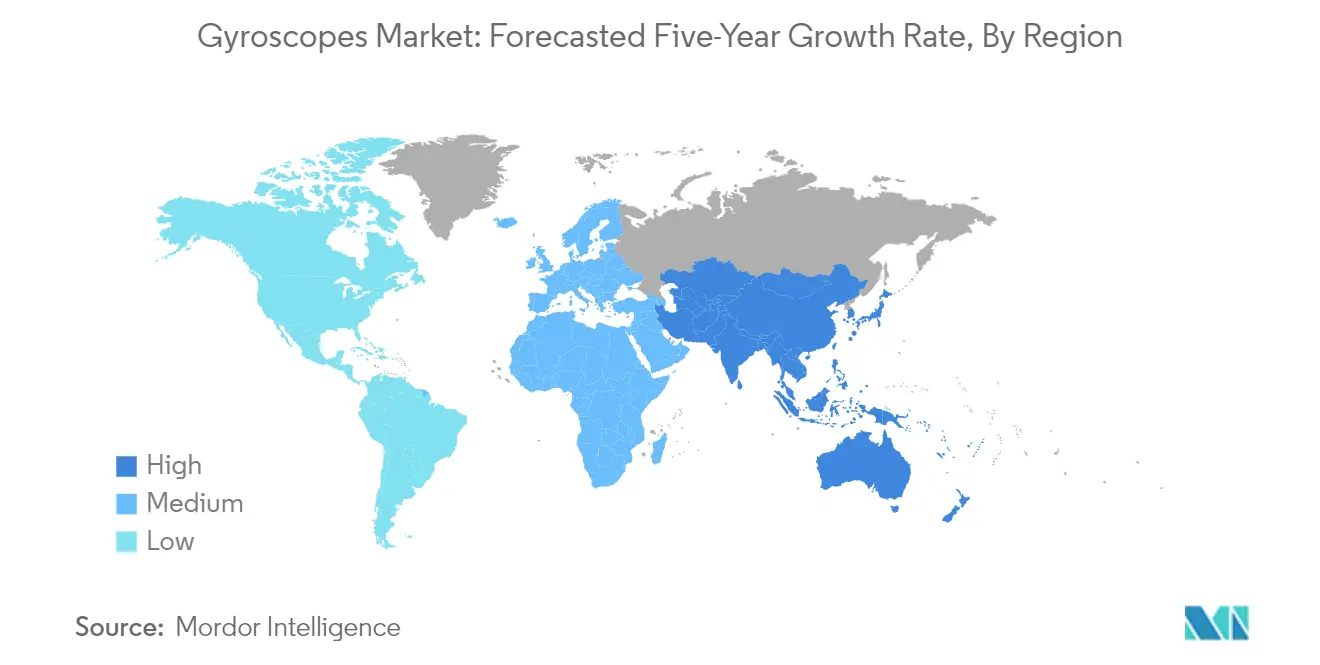
Gyroscopes Market in the United States
The United States dominates the North American gyroscopes market, holding approximately 90% of the regional gyro market share in 2024. The country's market is driven by significant investments in defense and aerospace applications, with the Pentagon announcing new programs focused on building thousands of autonomous systems. The presence of leading manufacturers and continuous technological innovations in MEMS gyroscopes, fiber optic gyroscopes, and ring laser gyroscopes further strengthens the country's position. The robust manufacturing sector and increasing adoption of Industry 4.0 technologies also contribute to market growth.
Gyroscopes Market in Canada
Canada emerges as the fastest-growing market in North America, with a projected growth rate of approximately 7% during 2024-2029. The country's market is experiencing rapid expansion due to increasing investments in aerospace and defense, industrial automation, and electronics sectors. The Canadian government's initiatives to enhance defense capabilities and procure UAVs, coupled with the growing automotive manufacturing sector, are driving market growth. The country's focus on advanced manufacturing technologies and robotics solutions further accelerates market development, particularly in the automotive gyroscope sector.
Gyroscopes Market in Europe
The European gyroscopes market demonstrates strong growth potential, supported by advanced manufacturing capabilities, robust aerospace and defense sectors, and increasing adoption of automation technologies. Germany, the United Kingdom, and France are the primary markets in the region, each contributing significantly to the overall market development. The region's growth is driven by increasing investments in autonomous vehicles, industrial robotics, and defense applications, highlighting the importance of the gyroscope global market.
Gyroscopes Market in Germany
Germany leads the European gyroscopes market, commanding approximately 32% of the regional market share in 2024. The country's strong engineering and manufacturing capabilities contribute significantly to market growth. Germany's focus on Industry 4.0 initiatives, particularly the 2030 vision for Industry 4.0 in strategic fields of action, including autonomy, interoperability, and sustainability, drives the demand for gyroscopes in various applications. The presence of major automotive manufacturers and increasing investments in defense modernization further strengthen the market, especially in the automotive gyroscope industry.
Gyroscopes Market in France
France represents the fastest-growing market in Europe, with a projected growth rate of approximately 7% during 2024-2029. The country's market is driven by significant investments in autonomous vehicle development, aerospace applications, and defense modernization programs. France's strong focus on developing advanced UAVs, increasing defense spending, and growing automotive sector contribute to market expansion. The country's initiatives in electric mobility and industrial automation further accelerate market growth, enhancing its position in the gyro industry.
Gyroscopes Market in Asia-Pacific
The Asia-Pacific region represents a dynamic market for gyroscopes, characterized by rapid industrialization, increasing defense modernization, and a growing consumer electronics sector. China, Japan, and India emerge as the key markets, each contributing significantly to regional growth. The region's market is driven by increasing investments in autonomous vehicles, robotics, and defense applications, coupled with the strong presence of consumer electronics manufacturers.
Gyroscopes Market in China
China dominates the Asia-Pacific gyroscopes market, driven by its massive investments in industrial robotics, consumer electronics manufacturing, and defense applications. The country's Made in China 2025 initiative, focusing on high-tech manufacturing including electric vehicles, next-generation IT, and advanced robotics, significantly influences market growth. The strong presence of consumer electronics manufacturers and increasing adoption of automation technologies further strengthen China's market position, particularly in the marine gyroscope sector.
Gyroscopes Market in China
China also emerges as the fastest-growing market in the Asia-Pacific region, supported by rapid industrialization and technological advancement. The country's focus on developing autonomous vehicles, increasing defense capabilities, and expanding consumer electronics production drives market growth. The government's initiatives to promote industrial automation and smart manufacturing, coupled with rising investments in research and development, further accelerate market expansion.
Gyroscopes Market in Rest of the World
The Rest of the World market, encompassing regions in the Middle East & Africa and Latin America, shows promising growth potential in the gyroscopes market. Countries in the Middle East, particularly the UAE and Saudi Arabia, are taking substantial steps towards embracing technologies such as 5G, AI, automation, and robotics. The region's growth is driven by increasing investments in defense modernization, autonomous vehicles, and industrial automation. Brazil emerges as both the largest and fastest-growing market in this region, supported by its strong manufacturing sector and increasing adoption of electric vehicles and autonomous technologies.
Competitive Landscape
Top Companies in Gyroscopes Market
The gyroscopes market features prominent manufacturers like Murata Manufacturing, STMicroelectronics, Honeywell International, Analog Devices, Robert Bosch, MEMSIC, EMCORE Corporation, InnaLabs, MicroStrain, VectorNav Technologies, and Dynalabs. These companies are heavily investing in research and development to drive product innovation, particularly focusing on miniaturization and improved accuracy of gyroscope sensors. The industry witnesses continuous product launches and technological upgrades, with companies expanding their scales of operation through market expansions and strategic acquisitions. Many players are vertically integrating their manufacturing capabilities while maintaining quality certifications like ISO 9001 and AS9100. Companies are also strengthening their positions through partnerships and collaborations across the value chain, from raw material suppliers to end-users.
Market Dominated by Diversified Technology Conglomerates
The gyroscopes market structure is characterized by the strong presence of large multinational corporations with substantial manufacturing, marketing, and R&D resources. These established players have formed long-term alliances with raw material suppliers and equipment providers to ensure continuous innovation and supply chain stability. The market shows moderate consolidation, with major players continuously expanding their market presence through strategic acquisitions of promising new entrants and technology companies to strengthen their product portfolios and regional presence.
The competitive landscape is marked by significant barriers to entry, including high capital requirements and the need for sophisticated manufacturing capabilities. While established players benefit from economies of scale and strong distribution networks, regional specialists maintain their presence through a focus on niche applications and specific geographic markets. The industry witnesses ongoing consolidation through mergers and acquisitions, particularly targeting companies with complementary technologies or strong regional presence to enhance market coverage and technological capabilities.
Innovation and Adaptability Drive Market Success
Success in the gyroscopes market increasingly depends on companies' ability to develop innovative products that meet evolving customer requirements across various industries, from consumer electronics to aerospace and defense. Market leaders are focusing on developing customized solutions for specific applications while maintaining cost competitiveness through efficient manufacturing processes. Companies are also investing in advanced technologies like MEMS and expanding their software integration capabilities to provide comprehensive solutions that address emerging applications in autonomous vehicles, robotics, and IoT devices.
For new entrants and smaller players, success lies in identifying and serving niche market segments while building strong relationships with end-users in specific industries. The market shows relatively low substitution risk due to the essential nature of gyro technology in many applications, but regulatory compliance, particularly in aerospace and defense applications, remains crucial. Companies must maintain strong quality management systems and certifications while continuously adapting to evolving industry standards and environmental regulations. Future success will increasingly depend on the ability to provide integrated solutions that combine hardware excellence with advanced software capabilities, including digital gyroscope and motion tracking sensor technologies.
Gyroscopes Industry Leaders
-
Murata Manufacturing Co. Ltd
-
STMicroelectronics NV
-
Honeywell International Inc.
-
Analog Devices Inc.
-
Bosch Sensortec Gmbh (Robert Bosch GmbH)
- *Disclaimer: Major Players sorted in no particular order
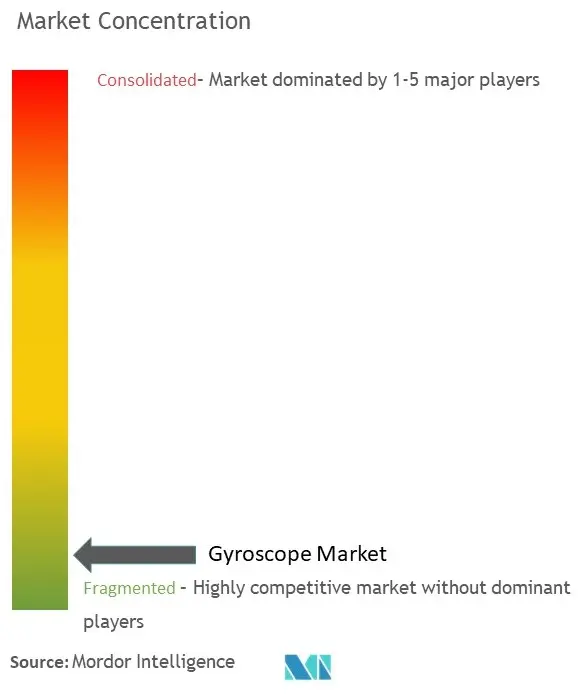
Recent Industry Developments
- October 2023 - Honeywell expanded its HGuide industrial navigation portfolio by adding a new Inertial Measurement Unit (IMU), the HGuide i400. This new IMU is specifically designed for a wide array of defense, industrial, and autonomous applications across air, land, and sea vehicles and related equipment. The HGuide i400 IMU, boasting a Gyro Bias Repeatability of under one degree per hour, sets a new standard for compact precision. Measuring just 28 mm x 25 mm, it delivers performance without compromising size or weight compared to existing units.
- September 2023 - EMCORE Corporation introduced the TAC-440 MEMS Inertial Measurement Unit (IMU), the world’s smallest 1°/hour IMU. Featuring an ultra-compact package of less than five cubic inches, the TAC-440 is a higher-performance, form, fit, and function-compatible replacement for the Honeywell 1930 and 4930 IMUs.
Global Gyroscopes Market Report Scope
Gyroscopes are defined as sensors that are used for the measurement of orientation in multiple devices. Since their inception, gyroscopes have evolved considerably, primarily aided by incremental technological innovations. This has helped them emerge as one of the most integral components in any navigation system.
The gyroscopes market is segmented by technology (MEMS gyroscope, fiber optic gyroscope (FOG), ring laser gyroscope (RLG), hemispherical resonator Gyroscope (HRG), dynamically tuned gyroscope (DTG), and other technologies), by end-user vertical (consumer electronics, automotive, aerospace, and defense, industrial, marine, and other end-user verticals), and by geography (North America [United States, Canada], Europe [Germany, United Kingdom, France, Rest of Europe], Asia Pacific [China, Japan, India, Rest of Asia Pacific], rest of the World). The report offers market forecasts and size in value (USD) for all the above segments.
| MEMS Gyroscope |
| Fiber Optic Gyroscope (FOG) |
| Ring Laser Gyroscope (RLG) |
| Hemispherical Resonating Gyroscope (HRG) |
| Dynamically Tuned Gyroscopes (DTG) |
| Other Technologies |
| Consumer Electronics |
| Automotive |
| Aerospace and Defense |
| Industrial |
| Marine |
| Other End-user Verticals |
| North America | United States |
| Canada | |
| Europe | Germany |
| United Kingdom | |
| France | |
| Asia | China |
| Japan | |
| India | |
| Australia and New Zealand | |
| Latin America | |
| Middle East and Africa |
| By Technology | MEMS Gyroscope | |
| Fiber Optic Gyroscope (FOG) | ||
| Ring Laser Gyroscope (RLG) | ||
| Hemispherical Resonating Gyroscope (HRG) | ||
| Dynamically Tuned Gyroscopes (DTG) | ||
| Other Technologies | ||
| By End-user Vertical | Consumer Electronics | |
| Automotive | ||
| Aerospace and Defense | ||
| Industrial | ||
| Marine | ||
| Other End-user Verticals | ||
| By Geography | North America | United States |
| Canada | ||
| Europe | Germany | |
| United Kingdom | ||
| France | ||
| Asia | China | |
| Japan | ||
| India | ||
| Australia and New Zealand | ||
| Latin America | ||
| Middle East and Africa | ||
Key Questions Answered in the Report
How big is the Gyroscopes Market?
The Gyroscopes Market size is expected to reach USD 4.56 billion in 2025 and grow at a CAGR of 6.10% to reach USD 6.13 billion by 2030.
What is the current Gyroscopes Market size?
In 2025, the Gyroscopes Market size is expected to reach USD 4.56 billion.
Who are the key players in Gyroscopes Market?
Murata Manufacturing Co. Ltd, STMicroelectronics NV, Honeywell International Inc., Analog Devices Inc. and Bosch Sensortec Gmbh (Robert Bosch GmbH) are the major companies operating in the Gyroscopes Market.
Which is the fastest growing region in Gyroscopes Market?
Asia Pacific is estimated to grow at the highest CAGR over the forecast period (2025-2030).
Which region has the biggest share in Gyroscopes Market?
In 2025, the Asia Pacific accounts for the largest market share in Gyroscopes Market.
What years does this Gyroscopes Market cover, and what was the market size in 2024?
In 2024, the Gyroscopes Market size was estimated at USD 4.28 billion. The report covers the Gyroscopes Market historical market size for years: 2019, 2020, 2021, 2022, 2023 and 2024. The report also forecasts the Gyroscopes Market size for years: 2025, 2026, 2027, 2028, 2029 and 2030.
Page last updated on:
